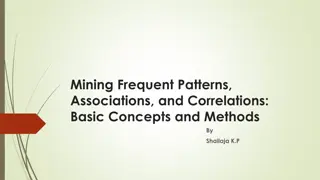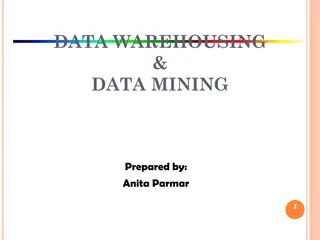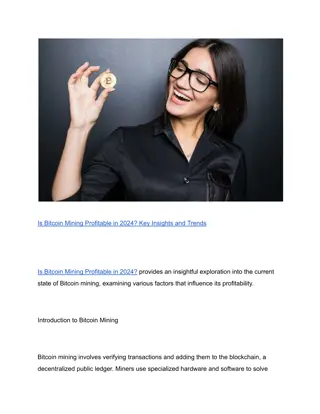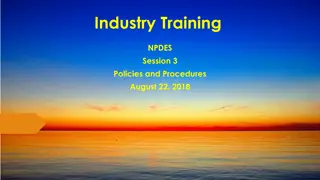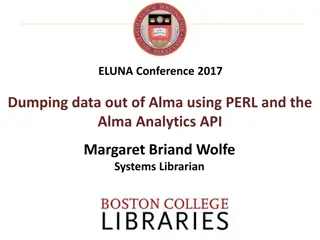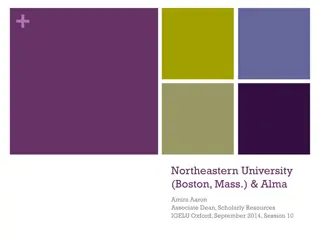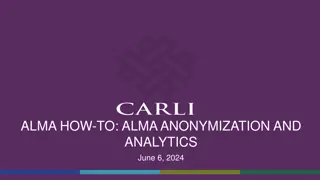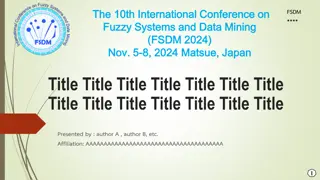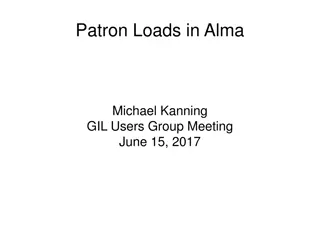Automated Data Mining Toolkit for ALMA Science Products
The ADMIT (ALMA Data Mining Toolkit) developed by the University of Maryland, University of Illinois, and NRAO enables the generation of science products from data cubes. It supports first-view data products like spectra, line identification, and moment maps, facilitating analysis for galaxies like NGC 253. Operating on data cubes in FITS or casa image formats, ADMIT offers self-documenting products compatible with the CASA environment. Users can utilize standard or custom products, including line-based operations and position-velocity slices. Two operation modes, in-line and off-line, cater to different user needs, with a browser-based viewer for data inspection. The toolkit fosters an in-depth exploration of data sets, offering tools for large data cube examination.
Download Presentation

Please find below an Image/Link to download the presentation.
The content on the website is provided AS IS for your information and personal use only. It may not be sold, licensed, or shared on other websites without obtaining consent from the author.If you encounter any issues during the download, it is possible that the publisher has removed the file from their server.
You are allowed to download the files provided on this website for personal or commercial use, subject to the condition that they are used lawfully. All files are the property of their respective owners.
The content on the website is provided AS IS for your information and personal use only. It may not be sold, licensed, or shared on other websites without obtaining consent from the author.
E N D
Presentation Transcript
ADMIT: ALMA Data Mining Toolkit Developed by University of Maryland, University of Illinois, and NRAO (PI: L. Mundy) Goal: First-view science data products into archive: spectra, line ID, moment maps, etc Goal: Python Toolkit allows user to generate their own science products from cubes. Galaxy NGC 253 ADMIT Products shown from automated flow Moment 0 Example Spectrum for line ID Moment 1 Moment 2 Identification of common lines Moment maps for lines
ADMIT Operates on data cubes only; cubes can be FITS or casa image format Compatible with CASA environment and utilizes CASA routines where possible Products are self-documenting with XML; compatible with future ingestion by a database Serpens Main Mosaic Image CS Each data cube get a full set of products See: admit.astro.umd.edu/admit-M4 and click on and xxx.admit directory C34S H2CO Spectra based on peak flux and noise in each channel Moment 0 Blue and green spectra highlight impact of missing flux Moment 1 Moment 2 Two spectra used in line ID of CS J=5-4
ADMIT Two modes of Operation: In-line (pipeline mode producing standard set of products): ADMIT runs after QA2 and before archive ingestion (ideally as a pre-step to the archive ingest process) details being worked with ALMA Project ALMA archive user can select to download ADMIT tarball (20-40Mb) XML, PNG, and HTML files; limited FITS files details to be decided with ALMA Project Browser-based viewer allows user inspect products once downloaded ADMIT summary XML file allows user to recreate the ADMIT products Off-line (user created data products): The ADMIT Toolkit add-on available from the CASA download page Flow-model for creating and re-creating products - viewable in the browser Environment for expanded exploration of data sets: Principle component analysis of emission Overlap integrals Comparisons across multiple windows and multiple sources New tools for examining large data cubes ASAC 2015 October 3
ADMIT Automated line ID which allows line-based operations: moment maps, PV slices, etc Pipeline produces set products for users which can be determine by ALMA Users can create their own custom products locally, which can be applied across sources Position-Velocity Slice Conservative automated line ID: do no bad ID Moment 0 Position along line Line for P-V slice Spectrum: peak emission over noise per channel Velocity 4
ADMIT Timeline for Science users: November 2015: Requested start date for testing of Cycle 3 data from imaging pipeline at ARCS. Needed for robustness testing against operational products in April 2016 Allows interaction with interested scientists to verify/improve products TBD: Deployment of ADMIT pipeline within ALMA to create products for archive ingestion. Date and final design to be decided in discussion with the ALMA project May 1 2016: Delivery of completed software system End of funded ALMA Development Project is April 30, 2016 Contract requires delivery of all software and documentation Options for continued support will be explored with ALMA/NRAO ASAC 2015October 5





